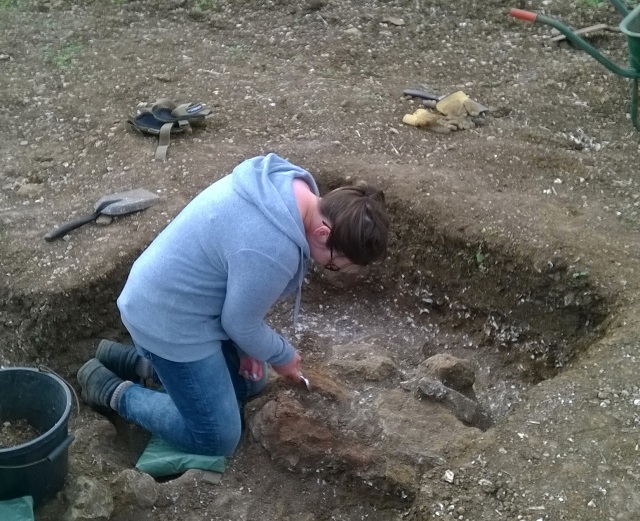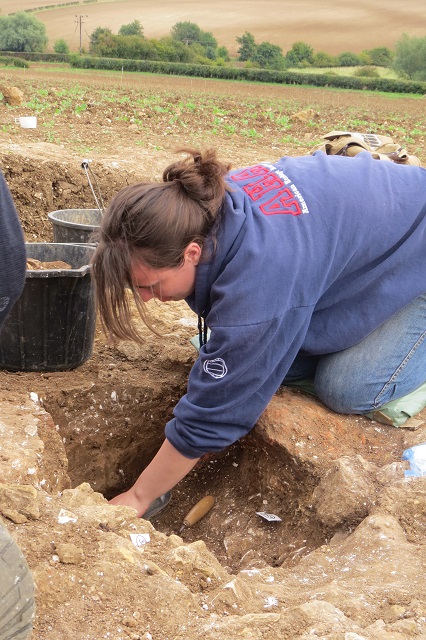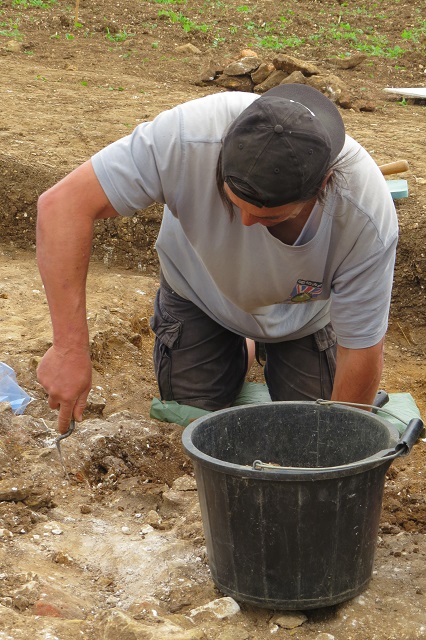Last few days of the dig and it has all been busy at trenches B and C. Here we update what has been happening at Trench C.
As soon as we had removed the topsoil at Trench C and cleaned the trench it was apparent we were on top of a very busy area with features and archaeological layers spread fully across the trench. We have now more clearly defined the foundations of the wall and the hard core for interior flooring (rammed ironstone). In the south east corner of our trench Lucas has excavated a square-cut pit, which seems almost certainly to have been a post pit that had contained a major structural timber (a roof support). A large pad or packing stone lay at the bottom of the feature. This led to the deduction of where a second structural feature could lie. We extended the trench and lo and behold a substantial pad of stones was revealed at the predicted location, thus fortifying the old adage that archaeology never lets you down! Here we show a photo of Antonia cleaning the pad stones. Evidently we have discovered a large aisled building of Roman date of a type known from several examples from eastern England including our one found at the Nettleton/Rothwell site previously.

Toni carefully cleaning our newly discovered post pad within the Roman building, for a detailed photograph
This was a good start to the day and the momentum continued as Norman discovered a coin by our wall foundation within minutes of wielding his trowel. This discovery is very helpful and suggests our ox bones from last week date to a similar period as this coin, that is in the first half of the 4th century AD. We have pressed on with defining and recording the wall foundations.
As is often the case with Roman corn-dryers, you find one and you soon realise it is one of several as this processing normally is clustered with repeated making and replacing of such dryers.
Danielle discovered what seems very likely to be a third, earlier, dryer cut through by Jonathan’s. Sufficient has survived for us to collect another sample for environmental analysis. Our dryers lie within the area of our building. They are late in the sequence of activity seen in this trench. Here as at other sites such ovens lying within the footprint of an earlier Roman building raise the question as to whether the building was still occupied at the time when this drying of the corn was so consistently undertaken.
Hard work all round has paid dividends with discoveries such as here at Trench C. While we have only been able to examine a small area the team has worked carefully and so we have a good record of this intense use of this part of the site. Whilst the archaeological remains are not simple to observe and excavate this all leads to improving the quality of the learning experience for seasoned diggers and those new to fieldwork alike. We were pleased to welcome Josh to join our team even before he has embarked on his degree in the Department of Classical and Archaeological Studies at the University of Kent. David, Neville and Graham have worked wonders at Trench B and we will update on their discoveries soon. We are grateful to the farmer for allowing access to the field in the brief window between harvest and re-sowing; the farmer now needs the field back for a 21st century grain crop. We turn now to the final recording and will update the blog in a couple of days.
The Dig Team



